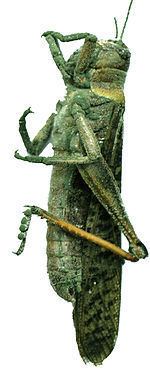Kingdom Fungi | Subphylum Pezizomycotina Scientific name Metarhizium acridum Rank Species | |
 | ||
Similar Metarhizium, Metarhizium anisopliae, Metarhizium flavoviride, Paecilomyces fumosoroseus, Beauveria | ||
Metarhizium acridum is the new name given to a group of fungal isolates that are known to be virulent and specific to Acrididea. Previously, this species has had variety status in Metarhizium anisopliae (var. acridum); before that, reference had been made to M. flavoviride or Metarhizium sp. describing an "apparently homologous and distinctive group" of isolates that were most virulent against Schistocerca gregaria in early screening bioassays.
Contents
Biology
M. acridum almost exclusively infects grasshoppers in the suborder Caelifera of the Orthoptera. Various research groups, including the international LUBILOSA Programme [1] (which developed the product 'Green Muscle') have identified and addressed key technical challenges for exploitation of microbial control agents including: isolate selection, mass production and delivery systems (formulation and application). In other words, insect control (mortality) depends on factors like the number of spores applied against the insect host, the formulation and weather conditions. Oil-based formulations allow the application of fungal spores under dry conditions, and are compatible with existing Ultra-Low Volume (ULV) application techniques for locust control.
Metarhizium acridum only targets and affects grasshoppers and locusts. Researchers wanted to know why this parasite was so specific to its target. Researchers believe that this has to do with the Mest1 gene which is not present in M. acridum. A study done by researchers from China tested the function of this gene. By taking a strain of M. robertsii that has a non-functioning Mest1 gene, researchers found that the mutant was only able to infect grasshoppers and locusts which is consistent with M. acridum. This Mest1 gene is what allows the initiation of the infection process on the specific targets. The expression of this Mest1 gene in the parasite M. acridum is triggered by substances that are only found on the waxy coat of the grasshoppers, which explains why this parasite specifically only targets grasshoppers and locusts.
Metarhizium acridum is currently under consideration by the USDA for release in the Western U.S. for control of native grasshoppers and crickets.
